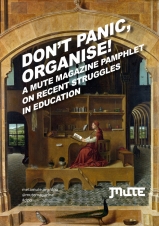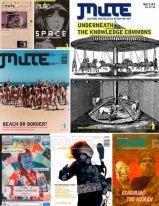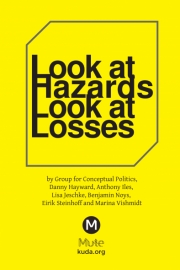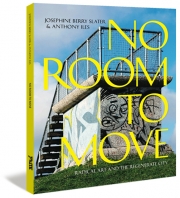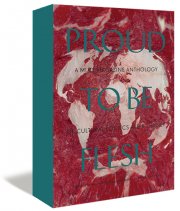Looking for an Argument
Tom Roberts visits artist filmmaker Anthony McCall's first solo exhibition in the UK, as part of the AV Festival, and traces the shift from 'heavy industry' to ‘information economy’ presaged by the artist's work and the context of the show 
In a talk given to accompany the exhibition of his new work Swell at the Reg Vardy Gallery in Sunderland, Anthony McCall likened his artistic career to the tale of Rip Van Winkle. Trained as a designer, between 1973 and 1975 he developed a range of 'solid-light' film projections and installations, which aimed to provoke a participatory mode of viewing by drawing the audience’s attention to the technical and perceptual mechanisms of film projection. McCall characterises this period as being shaped by a bad marriage with the exhibition industry. Artists’ cinema was relegated to the programming of events on the sidelines of gallery display. This lead him to show his work in the marginalised lofts and warehouse spaces rented by avant-garde film societies in New York and London. There followed an extended sleep, in which his day job as a designer took over, before he awoke around 1999 to find a public, and museums and galleries happy to exhibit his work on a major scale.
It’s a neat summation. But unlike Rip Van Winkle, Anthony McCall never really fell asleep. During his twenty year absence from the role of practising artist, McCall had to make a living: his design agency, Anthony McCall Associates, styled catalogues and monographs for major clients such as the Bilbao and New York Guggenheims; produced advertising for AXA Art Insurance, and gave the Art Dealers Association of America its graphic identity. It is the relationship between economic participation in the production of an ‘art world’ and an ‘art market’, and the desire to produce a place within it from which to critique the terms on which it operates, that is put into question in a section of the recently excavated Argument, a film McCall made in collaboration with media analyst Andrew Tyndall in 1978, in which two synched voices satirically intone:
‘I spend all my energies at work trying to make things run efficiently, so that I can make enough money to disrupt things efficiently in my art.’
I saw Argument a month or so before I saw Swell. On the train to Newcastle I was plagued by the idea that Argument, its mode of operation and the avant-garde peer-group audience it was intended for, might be incompatible with the logic of Swell and the kind of art it might be situated alongside. In the new work's address to an unproblematised public, Argument seems forgotten except as a critique dredged up from the artist’s past to haunt the foggy airs of his recent gallery installations. So, I’ll write about Argument, but I’ll write about Swell first. This is partly because I do not want to propose a simple dialectic between the two works but also because I’m fascinated by the idea that a career might encompass these very diverse strategies.
The re-evaluation of McCall's 1970s work has taken place on the terms of an art world whose dominant mode of exhibition is now centred on the culture of the screen. This change in the attitude of art institutions to time-based work, along with a personal desire to further explore the three-dimensional dynamics of projection, has prompted Anthony McCall to revisit his ‘solid light' strategy in a series of new installations. This includes Swell, co-commissioned by the Reg Vardy Gallery and AV ’06, a festival of electronic and new media arts. AV took place across Newcastle, Gateshead, Sunderland and Middlesborough. Around the theme 'life:like', the festival pulled together disparate events perceived to deal with the 'natural and synthetic', the interface between human perceptions and technology.
The Reg Vardy Gallery is part of the University of Sunderland’s Department of Arts, Design, Media and culture, located on the edge of Bockhouse Park. For Swell, a fifty-foot rectangular room has been partitioned to house the installation. On entering the room, which has been painted black, the audience faces a projector beam emitted from a point about five feet up, in a closed-off stand in the centre of the far wall. The beam extends from this point to the wall closest to the entrance. A haze machine in the far right-hand corner of the room emits puffs of fog every few minutes, feeding the light emitted by the projector and giving it a semi-solid, three-dimensional quality. The specific forms that appear along the length of the beam are rendered from a computer animation of a straight line and a travelling wave, white lines on black slowly intersecting; the 2-dimensional lines of the computer animation can be seen on the wall that forms the 'base' of the light beam. The 33 minute ‘cycle’ is looped.
 Swell, 2005, installation view
Swell, 2005, installation view
In the narrow corridor outside the installation room, framed and signed line drawings showing the animation in sequence are hung on the wall, accompanied by a pencil drawing depicting a 3-D view of the solid light beam.
I stayed in the room for just over the 33-minute duration of the animation, or long enough to figure out when the loop had started over again. The installation certainly made me acutely aware of the time it took to build up an awareness of its effects. As the numerous descriptions of McCall’s solid light works (old and new) state, I was compelled to move up and down the room, and in and out of the beam, taking stock of the evolving dynamics of the three-dimensional light forms over time. It was a Saturday lunchtime, and I brought a friend. Once or twice we asked each other questions as to how the piece might be composed. At different moments during the cycle, I enjoyed fitting my head inside the light forms, or standing immersed in the titled plane of the straight line before the wave form subsumed it. Two other visitors entered the room for a few minutes, a middle-aged woman and a teenaged boy. The woman remarked that it was funny how people always seem to want to enter the beam, so I assumed she’d visited the installation before. This recognition added to the information I was building up around the piece. It’s quite hard to describe the precise effects of Swell, as it fosters a very of-the-moment feeling. But it seems to operate on a strange, frozen tension between pieces of information that would normally work dialectically, both sharpening the senses, and suspending disbelief.
I took some pleasure in Swell, and I don’t want to suggest that, taken purely on its own terms, it is not an involving, even enchanting, installation. But works don’t just work on their own terms, and outside the immediate experience of the exhibition I would question the nature and extent of the criticality that has been ascribed to McCall’s revisiting of the solid-light works in a modern-day gallery environment.
The first run of solid-light works in the 1970s have been positioned against the medium-specificity of the structuralist or ‘materialist’ film-making that was the dominant mode of avant-garde film work at that time, particularly in the UK.[1] Materialist film was attended by a political rhetoric that arguably confused a high-modernist absorption in the intrinsic qualities of film with a pseudo-Marxist 'resistance' to the ideological mechanisms associated with popular forms of cinematic representation. McCall’s innovation was to open cinema out in three dimensions, giving it a sculptural quality that required a more mobile spectator to take it all in. Christopher Eamon has pointed out the irony by which
'McCall’s solid light films had arguably been overtaken by a modernist context, which accrued around the work in the later 1970s. This emphasis on structuralism began to overshadow the implications for viewer and audience implicit in it.'[2]
Indeed, Eamon’s suggestion is doubly ironic in that McCall placed new emphasis on the 'sculptural’ quality of his recent solid-light works during his talk at Reg Vardy, whilst elsewhere giving credence to the presented of the new installations as critical of the modes of viewing invited by large-scale gallery projections and of the conventions of film and video projection more generally. This critical potential has been discussed by the artist himself as part of a round-table debate on projection in contemporary art for the journal October, 2003, and in two recent books: The Solid Light Films and Related Works edited by Christopher Eamon, and Film Installations by Helen Legg. The discourse seeking to find criticality in McCall’s installations does not find it in an explicit questioning of the economic or social codes of the gallery or museum, but instead in a series of spatial, perceptual and conceptual interventions that might lead to a more active engagement with the space of exhibition. Participation, then, 'within and against this newly transformed institutional site', as Branden W. Joseph puts it, is key to the works’ critical potential.
 Between You and I, 2005 installation drawing
Between You and I, 2005 installation drawing
But how is this participation called upon, and to what ends? Reading through the press material, art-historical and critical work on McCall, I couldn’t get an impression of what the audiences’ involvement, or interaction, was really like in the case of each work. Instead, I found a series of assumptions about the character of participation that seemed to be based more on the intentionality of the installations, as well as the interests of the critics.
'Unlike conventional film or video, Swell’s audience is encouraged to move around the space, finding their own perspectives as the room-sized membranes of light rise, fall and turn through space.' Press release, Reg Vardy Gallery
What they share is a sense that the installations act on, rather than being acted on by, the audience; they are prescriptive and cannot account for the complexity of the audience’s response, or their use of the space.
It’s worth considering the processes by which participation in these works is converted into forms of value by the various bodies that commission them and disseminate information about them. The audiences for McCall’s solid light films have expended time on their experiences with the light beams. They have effectively been invited to perform labour, however close this labour may be to leisure. (In my case, it was closer to labour than leisure). This expenditure is implicit in the notion that the audience is part of the work. But, when the participation of the audience is iterated and re-iterated in essays, press releases, glossy books and verbal descriptions, the participants’ expenditure of time (labour) is objectified in these forms. That this process takes place through discursive practices and the circulation of print and digital media, rather than in a material object which we might identify as an artwork, is a contingency of the partly conceptual, ephemeral mode of the solid light installations. The representation of the work, as objectified labour (time), is then circulated, and becomes proof of McCall’s value – by critics, by curators, by festival organisers, etc., for the public, for curators, for peers, etc.
I want to ask whether the values imbued in these works as art works by institutions and critics, including the participatory value inscribed on them, locks McCall in serial (re)production of his solid light signature, modified for the needs and values of each venue and the interests of outside agencies.
For example, in the case of Swell, McCall’s practice has been adapted to the local context of Sunderland. Described as his 'first site-specific commission', Swell’s three-dimensional light forms were 'inspired by Sunderland’s coastal landscape' or more specifically, the wave action of the North Sea and the effects of the Roker Lighthouse in the fog. Although this fits in with McCall’s recent work in a geometric sense, and I can accept that it brings the commission in line with the AV Festival’s theme of virtualized nature, it also comes across as rather opportunistic. I couldn’t help but wonder if the value invested in the solid light works by today’s art world has been at least indirectly applied to Sunderland as part of the Newcastle Gateshead Initiative’s regeneration project.
Sunderland, like much of the North East, has seen heavy unemployment as a result of the decline and disappearance of its shipbuilding and mining industries in the late 1980s. This loss is supposedly being addressed through the proliferation of call-centres and service jobs in the region, as well as the activities of culture-led regeneration agencies like Newcastle Gateshead Initiative, a partnership between Newcastle and Gateshead city councils and private companies with business interests in the area. NGI, a ‘destination marketing agency’ for the North East, sees AV ’06 as part of its remit to attract investment in the area.
Given this context of industrial restructuring and culture-led economic ‘renewal’, McCall's responses during his talk at the Reg Vardy Gallery were suggestive. Asked if he saw a relationship between his solid light works and the large-scale sculptures of Richard Serra, McCall answered that the former was ‘heavy industry’ while he was more ‘information economy’, operating in relation to the laws of intellectual property. With art’s questionable role in regeneration and the critique of intellectual property currently hot topics, it’s unfortunate that he didn’t expand on this comment. I was left wondering how McCall sees his own work's function in an ‘information economy’ and how it might address this, beyond adoption of new technologies and the production of affect.
For a start, it would be good to see a deeper exploration of the ways in which different modes of appreciation are brought to bear by audiences on these installations, not simply in terms of the leisure / labour time expended by the audience in the immediate ‘here and now’ of the installation. The manner in which we interpret the work is partly shaped outside of the work’s conceptual loop of existence, in a prior relation to culture and its utilization in the educational and labour markets. Whether the discrete logic of the new solid light installations can really bear such an examination, is open to question. However, it doesn’t help that the recent attempts to give the works critical status tend to limit their analysis to a top-down conception of the kinds of viewing McCall’s practice might provide for, rather than detailing their current uses by a gallery-going public and the various institutions that commission the works.  Argument, film still
Argument, film still
Amid the revival of the solid light installations, comes the excavation of a moment in McCall’s career in which he repudiated his earlier films. A digital restoration of McCall and Andrew Tyndall’s Argument (1978) has recently been released by LUX and was screened at The Whitechapel Gallery in February of this year. The film opens with white typewriter lettering on a black field, declaring that
'the effectiveness of a work is measured by the way people see it'
against which a voice counters
'the effectiveness of a work is measured by the way people use it'
The logic of the film is both dialectic, it presents voice, image and caption as a series of ideological oppositions, and works through addition, it brings the second statement to bear on the first, employing a recognition of its terms in order to push beyond it. This logic is employed on three or more distinct discourses in the film:
1. There are series of long, static shots of spreads from a colour supplement of the New York Times: Clipped to a string; laid in a faux-casual manner diagnonally across the paper; Pinned to a wall, or being flicked through, and occasionally cut with images from porn mags. Two voices interrogate the representations of masculinity inherent to them.
2. There are sections in which cut-out phrases in typewriter font are arranged and broken up against a red or black field: newspaper stories cut with polemics about the ideology of news media, and the basis of this ideology in a competitive market.
3. There are two sections in which the screen is blank (white), and the voices speak at the same time, reading the same text: a disquisition on the problematic relationship of the politically-engaged artist to his or her day job. In another section, a performer cross-dresses as artist and businessman while in the foreground a head, partly obscured by the static camera, details the film’s budget.
The film addresses the attitudes of what McCall, drawing on Peter Wollen’s ‘The Two Avant-Gardes’, identified as two distinct streams of film working in the 1970s – structuralism and semiology.[2] It has been described as, among other things, an answer to Jean Luc Godard and Jean-Pierre Gorin’s Letter to Jane (1972), an agitprop film in which the two film-makers alternately deconstruct a press shot of Jane Fonda’s visit to Hanoi in the Vietnam War:
The film suggested a methodology for an analytical reading of photographic images. In this way the 'text' of the film appeared to be the image, with the two film-makers sharing an analysis of it. In fact the text of the film included the soundtrack… The film-makers refused their audience the role vis-à-vis the film that they allowed themselves vis-à-vis the audience.
Anthony McCall and Andrew Tyndall, ‘Sixteen Working Statements’ [3]
In this sense, Argument can be seen as an attempt to generate a reflexively critical cinema: That is, that the social codes of avant-garde production should be opened up for analysis as much as those of the subjects it addresses. This element appears to have been drawn from both sociology and the reflexive theatrical and discursive practices of Bertolt Brecht. Where it is most successful in the film, is in the third stream of sequences I outlined above, which more directly address the economic conditions of avant-garde film production, and relate them to the attitudes artists take to their analysis of the social world. In the other sections, the reflexive approach seems to work through analogy. For example, the masculine representations as produced in the colour supplement are clearly drawn up in opposition to the self-image of the avant-garde film-maker as it is reproduced in both the art market and the media: An opposition which ironically binds the avant-gardist to the market. But this analogical approach, while it goes some way toward exposing these two apparently distinct representations as twinned by their uses in the market, does not go far enough in showing how the avant-garde produces its own social distinction from popular media.  Argument film still It is important to remember that the film was not intended to be seen as a (doubled) text in itself. Instead, having some basis in the same sense of marginalisation that McCall identified in the avant-garde and experimental film societies in his talk in Sunderland, Argument was intended as a model for the production of a ‘shared political film culture’ as it might be constituted in the specific milieu of the New York avant-garde, with a reflexive approach as its methodological basis.
Argument film still It is important to remember that the film was not intended to be seen as a (doubled) text in itself. Instead, having some basis in the same sense of marginalisation that McCall identified in the avant-garde and experimental film societies in his talk in Sunderland, Argument was intended as a model for the production of a ‘shared political film culture’ as it might be constituted in the specific milieu of the New York avant-garde, with a reflexive approach as its methodological basis.
The film itself was to function as a stimulus to discussion in a series of workshops, to which the membership of the Collective for Living Cinema and the Millennium Film Workshop were invited. This siting of a discursive space was positioned in opposition to the notion that political effectiveness might be obtained according to the extent of the exposure of an audience to a work (labelled ‘The Numbers Theory’ by the artists: the idea that the more people who see a work, the more effective it is, or might be). Instead, McCall and Tyndall argued, a film culture rooted in the specific concerns and conditions of avant-garde production should be measured for its use-value in and for that milieu.
The question, then, is how to keep the knowledge embodied in the film and in the workshops collectively active in relation to today’s art world, and perhaps more specifically in context of the artistic positions that are taken around the currency of ‘political’ art. That is, how to make it useful and figure out what ‘useful’ means in any given context. In this regard, I hope that Argument might find a suitably discursive environment, where the state of the argument as it was, and as it is, might be reinvigorated. Watching it in an auditorium as both an historical document and a film in itself, as opposed to watching it as part of a discursive event, the dynamics occasionally threaten to collapse into relativism.
One element of the film I found pertinent in light of the current state of cultural criticism, was the manner in which McCall and Tyndall appear to take position-taking to extremes. Indeed, at times it feels like they’ve scouted around, anticipating every conceivable position that might be taken in relation to the currency of ‘political’ art. Possibly to activate some useful conflicts in the workshop model, or, also possibly, in an all-out attempt to outgun their peers.
Argument could be useful in illuminationg the process by which a politically-engaged peer culture becomes a social market, with specific forms of knowledge employed in order to seek out advantageous positions in its structure. The very recognition of information as shaped by economics can itself be instrumental in securing or marking out a position in the market for cultural criticism, i.e. such a recognition can be converted into cultural capital and diverted into a quest for distinction in any one of a number of welcoming institutions, be they galleries, universities or sets of friends. In this way, the principle of novelty as a means of activating structural change, is bound to the tendency for novelty to get caught up in the production of difference inherent to artistic production and social competition:
‘The twin principles of modernism and marketing: seeing fresh promise in familiar things.’
To return to the problematic I experienced in thinking about Swell having just seen Argument, perhaps my difficulty was in trying to sketch a notion of an art world, somehow not just in terms of a ‘broad church’, in which they might coexist and function usefully for their different audiences. Behind the revivial of Anthony McCall’s career is the desire on the part of institutions, critics and curators to generate a greater involvement, or sense of investment, in the game of production immanent to moving-image culture as it is reconstituted in the spaces provided for it by the exhibition industry. But I wonder if the ultimate end of such an investment shouldn’t be to disassemble the valuing structures that invite this participation in the first place.
Tom Roberts is a digital technician and writer. He is currently developing an outline for the study of ‘cultural credit’, and trying to write a story shaped by learning done in public libraries.
FOOTNOTES
[1] Jonathan Walley, An Interview with Anthony McCall in C. Eamon (ed.) The Solid Light Films and Other Installations, Steidl 2005 p. 146 [2] ibid. p 14 [3] From Argument, a book published to accompany the workshops and republished by LUX
Mute Books Orders
For Mute Books distribution contact Anagram Books
contact@anagrambooks.com
For online purchases visit anagrambooks.com


